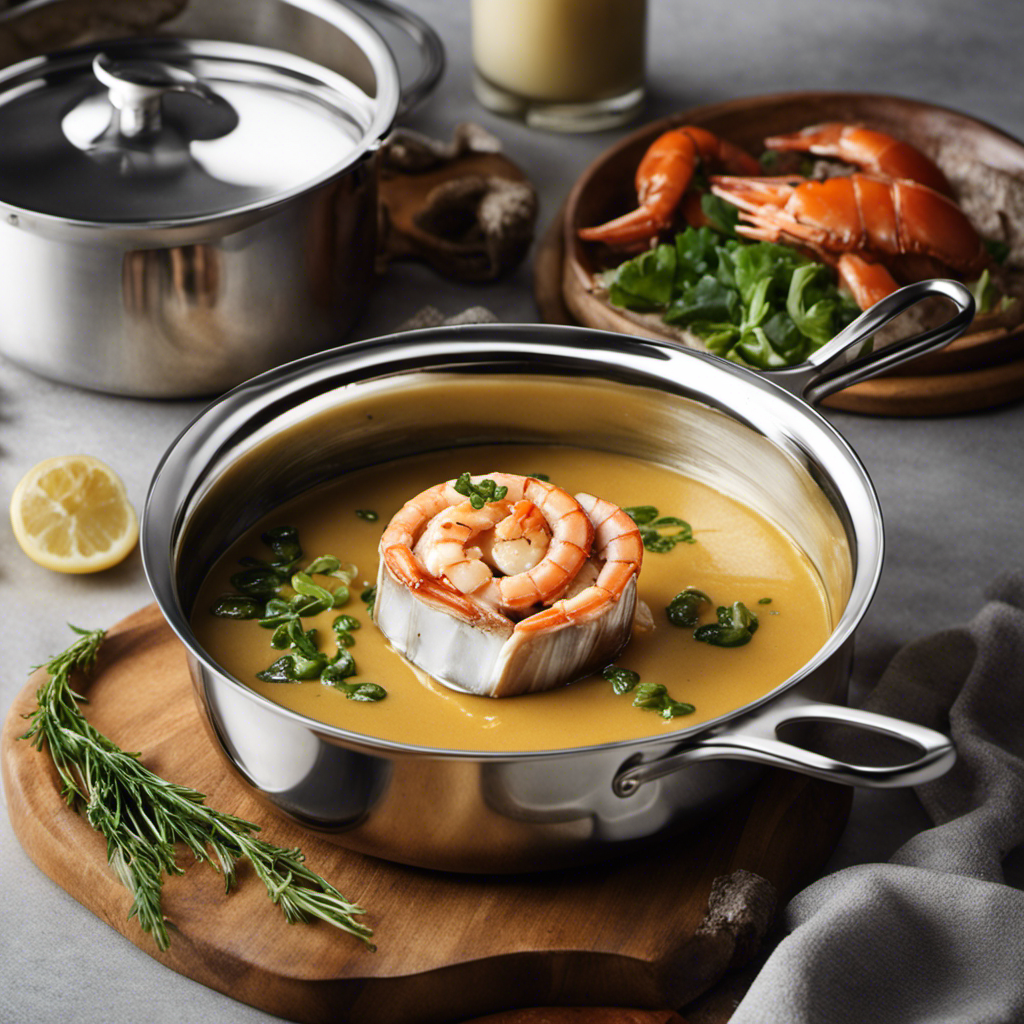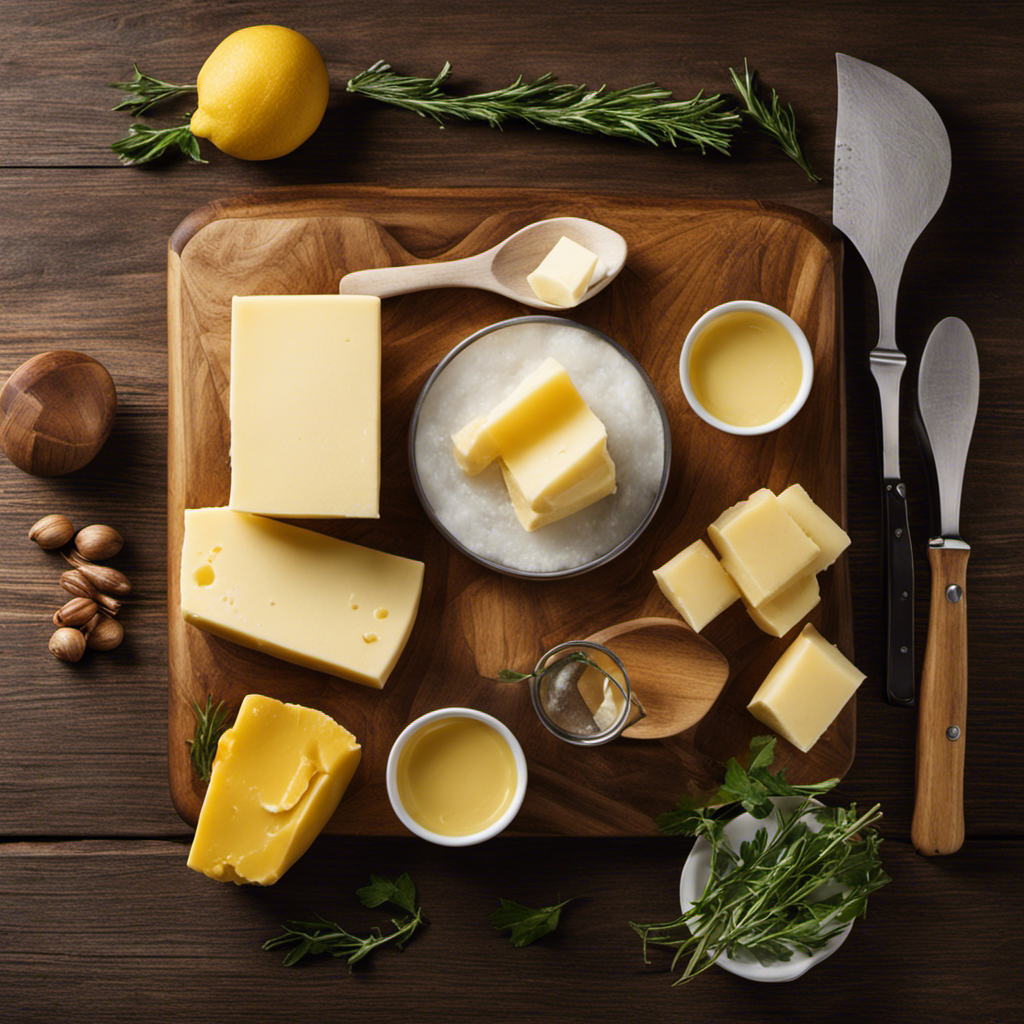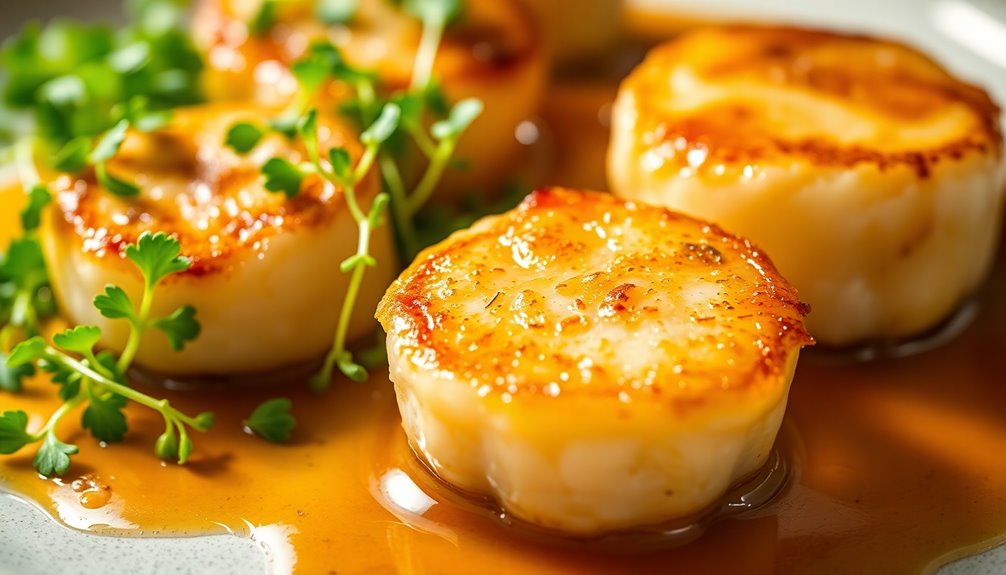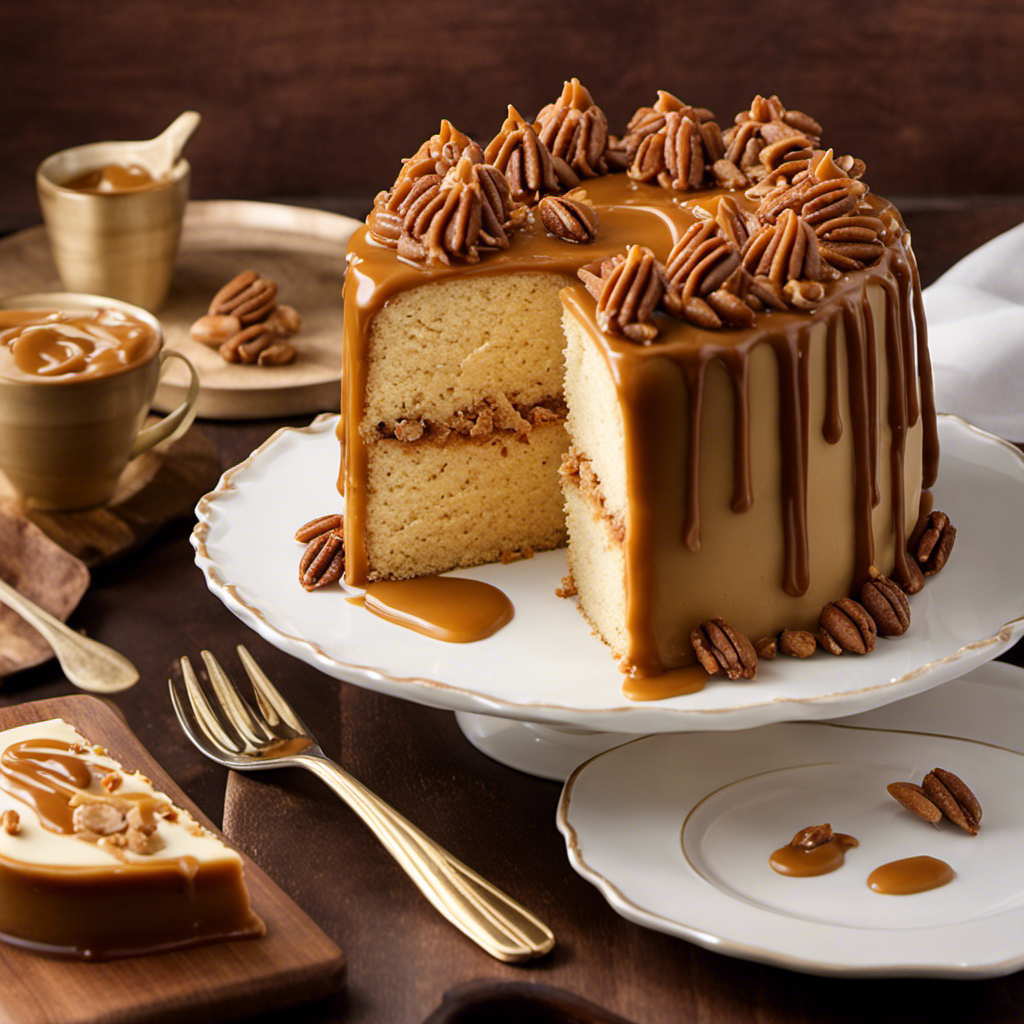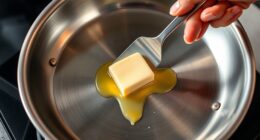Like a luxurious cloak enveloping delectable seafood, a rich butter sauce elevates any dish to unparalleled levels of decadence. In this tutorial, I will reveal my tips for crafting a sumptuous butter sauce that will enhance the flavors of your seafood dishes to a whole new dimension.
We’ll explore the art of selecting the perfect ingredients, melting butter to perfection, and infusing it with aromatic herbs and spices.
Get ready to tantalize your taste buds with the richness and depth of a homemade thick butter sauce.
Key Takeaways
- Choose unsalted butter for better control over the sauce’s saltiness.
- Opt for heavy cream instead of milk for a richer and thicker texture.
- Browning the butter adds a rich and nutty flavor.
- Experiment with different techniques to achieve the desired thickness.
Selecting the Right Ingredients
To make a thick butter sauce for seafood, you’ll need to choose the right ingredients. The key to achieving the desired consistency lies in the careful selection of these ingredients.
First and foremost, opt for unsalted butter as it allows you to control the saltiness of the sauce. Additionally, using heavy cream instead of milk will contribute to a richer and thicker texture.
To enhance the flavor, add a touch of garlic or shallots, finely minced. For a tangy twist, a splash of lemon juice can work wonders. Lastly, don’t forget to season with salt and pepper to taste.
By following these ingredient selection tips, you can ensure a velvety and luscious butter sauce for your seafood dishes.
Now, let’s move on to melting the butter.
Melting the Butter
After melting the butter, you can proceed to add the desired seasonings. This step is important because it allows the butter to develop a rich and nutty flavor through the process of browning.
Here are some alternative thickening methods to consider when making a butter sauce:
- Adding a small amount of flour or cornstarch to the melted butter can help thicken the sauce without altering the flavor too much.
- Whisking in a mixture of heavy cream and grated Parmesan cheese can create a creamy and indulgent texture.
- Using a roux, which is made by combining equal parts butter and flour, can give the sauce a velvety consistency.
By experimenting with these different techniques, you can achieve the perfect thickness for your butter sauce.
Now, let’s move on to adding the flavorful herbs and spices to enhance the taste of the sauce.
Adding the Flavorful Herbs and Spices
When it comes to adding flavor to your dishes, herb pairing suggestions, spice selection tips, and cooking time considerations are crucial elements to consider.
Choosing the right herbs to pair with your ingredients can elevate the taste profile of your dish, while selecting the appropriate spices can add depth and complexity.
Additionally, understanding the cooking time required for each herb and spice will ensure that their flavors are fully developed and integrated into your dish.
In this discussion, I will delve into these key points, providing knowledgeable and precise information to help you create flavorful and delicious meals.
Herb Pairing Suggestions
For the best flavor, try pairing your thick butter sauce with fresh herbs like basil or cilantro. These herbs not only add a burst of freshness but also complement the richness of the butter sauce. Here are some alternative herb options that you can consider for your sauce:
- Parsley: Known for its bright and clean flavor, parsley adds a touch of freshness to any dish.
- Dill: With its delicate and slightly tangy taste, dill pairs well with seafood, enhancing its natural flavors.
- Chives: These mild and onion-like herbs provide a subtle hint of flavor, adding a touch of elegance to your butter sauce.
When it comes to herb storage techniques, it is best to store fresh herbs in the refrigerator. To prolong their shelf life, you can wrap them in a damp paper towel and place them in a plastic bag. Alternatively, you can also freeze them by chopping them and placing them in ice cube trays with water or olive oil.
Spice Selection Tips
To add a kick of flavor to your dish, consider using a variety of spices like cumin, paprika, or chili powder. These spices can elevate the taste of your meals and create a unique dining experience. When it comes to spice pairing suggestions, it’s all about experimenting with different flavor profiles. Each spice brings its own distinct taste and aroma, and by combining them strategically, you can create a harmonious blend of flavors. To help you in your spice selection process, here is a table showcasing some popular spice pairings:
| Spice | Pairing Suggestions |
|---|---|
| Cumin | Coriander, turmeric, cinnamon |
| Paprika | Garlic, onion, oregano |
| Chili powder | Lime, cilantro, cayenne pepper |
| Ginger | Garlic, soy sauce, lime |
Cooking Time Considerations?
Cooking time can greatly affect the texture and flavor of your dishes, so it’s important to carefully consider how long each ingredient needs to cook. Here are some key points to keep in mind when it comes to cooking time:
-
Different cooking techniques require different times: Whether you’re grilling, sautéing, or baking, each method has its own specific time requirements. For example, grilling seafood usually takes less time than baking it.
-
Doneness depends on the desired flavor variations: Some people prefer their seafood to be cooked until it’s just done, while others like it well-done. Knowing your desired flavor variations will help you determine the cooking time.
-
Use a timer and trust your instincts: While recipe guidelines are helpful, it’s important to trust your instincts and use a timer to avoid overcooking or undercooking your seafood. Keep an eye on the color, texture, and smell to ensure it’s cooked to perfection.
Incorporating the Liquid Component
Once the butter has melted, I whisk in the cream and garlic to create a rich and flavorful sauce. This step is crucial in making a thick butter sauce that will perfectly complement a seafood medley.
The cream adds a creamy and velvety texture to the sauce, while the garlic provides a savory and aromatic element.
To enhance the flavor profile even further, I like to add a touch of sweetness. This can be achieved by incorporating a small amount of honey or maple syrup into the sauce. The sweetness balances out the richness of the butter and cream, creating a harmonious blend of flavors.
Thickening the Sauce With a Roux
After the butter has melted, I whisk in a mixture of flour and butter to thicken the creamy and flavorful sauce. This classic technique, known as making a roux, is a common method used in traditional French cooking.
However, there are alternative ways to achieve a thick sauce without using a roux. Here are some options to consider:
-
Cornstarch: A gluten-free alternative to flour, cornstarch can be mixed with water or another liquid to create a slurry that thickens the sauce.
-
Arrowroot: Similar to cornstarch, arrowroot is a natural thickening agent that works well in sauces. It has a more neutral taste compared to cornstarch.
-
Reduction: Simmering the sauce for a longer period of time can help evaporate excess liquid, resulting in a thicker consistency.
These alternatives can be used depending on dietary restrictions or personal preferences. Experiment with different methods to find the perfect thickness for your butter sauce.
Enhancing the Texture With Cream or Cheese
To create a rich and velvety texture, you can add cream or cheese to your sauce, giving it a luscious and indulgent taste. When it comes to thickening a sauce, using cream or cheese offers distinct advantages and drawbacks.
Cream adds a smooth and creamy texture to the sauce, enhancing its richness. It also helps in balancing out any strong flavors and adds a touch of sweetness.
On the other hand, cheese brings a unique depth of flavor and a slightly tangy taste to the sauce. However, it can overpower the other ingredients if not used in moderation.
If you prefer a lighter option, there are alternative thickening methods to consider, such as using cornstarch, flour, or even pureed vegetables. These methods can help achieve a thick sauce without the added richness of cream or cheese.
Seasoning and Adjusting the Sauce to Taste
When it comes to seasoning and adjusting a sauce to taste, there are a plethora of flavor customization options that can be explored. From adding herbs and spices to incorporating different types of liquids, the possibilities are endless.
One important aspect to consider is balancing the richness and acidity of the sauce. It’s crucial to find the right balance between the creaminess and tanginess to create a harmonious flavor profile that enhances the overall dish.
Flavor Customization Options
You can easily customize the flavor of your thick butter sauce for seafood by adding different herbs and spices. This allows you to create a sauce that perfectly complements your dish and enhances its flavors.
Here are some flavor combinations that work well with seafood:
-
Lemon and dill: The freshness of lemon combined with the aromatic dill creates a light and zesty flavor profile.
-
Garlic and parsley: The pungent garlic pairs beautifully with the earthy parsley, adding depth and richness to your sauce.
-
Chili and cilantro: For those who prefer a bit of heat, the fiery chili combined with the fresh and citrusy cilantro creates a bold and vibrant flavor combination.
To adjust the consistency of your sauce, you can add more butter or cream to make it thicker, or add a splash of broth or wine to make it thinner. Remember to taste and adjust the seasoning accordingly.
Experiment with these flavor combinations and tips to create a butter sauce that elevates your seafood dishes to the next level.
Balancing Richness and Acidity
Achieving the perfect balance between richness and acidity is crucial when creating a flavorful sauce to enhance the flavors of your seafood dishes.
Balancing creaminess and tanginess is a delicate task that requires careful consideration of the ingredients you use. To achieve the desired creaminess, I recommend incorporating ingredients like heavy cream or butter into your sauce. These will add a rich and velvety texture to the dish.
However, it’s equally important to balance this richness with a touch of tanginess. Experimenting with different acid sources such as lemon juice, white wine, or vinegar can help achieve this balance. Start by adding a small amount and taste as you go, adjusting the acidity to your preference.
Frequently Asked Questions
Can I Use Margarine Instead of Butter for the Sauce?
Using margarine instead of butter in the sauce has pros and cons. Margarine can alter the taste and texture of the sauce, making it less rich and creamy. However, it can still be a viable option if you prefer a lighter sauce.
How Long Should I Melt the Butter For?
I usually melt the butter for about 1-2 minutes until it’s completely melted. As for the amount, it depends on how much sauce you want. To enhance the flavor, you can add garlic, lemon juice, or herbs like parsley and dill.
Can I Use Dried Herbs Instead of Fresh Ones?
Yes, dried herbs can be used in place of fresh ones. They provide a similar flavor, but remember to use less as they tend to be more concentrated. Additionally, you can try using alternative fats like olive oil or coconut oil instead of butter for the sauce.
What Type of Liquid Can I Use to Incorporate Into the Sauce?
To make a thick butter sauce for seafood, you can incorporate various types of liquid. Different types of alcohol, like white wine or brandy, can add flavor. However, be aware of the pros and cons of using different liquids in your sauce.
Can I Use a Cornstarch Slurry Instead of a Roux to Thicken the Sauce?
Yes, you can use a cornstarch slurry instead of a roux to thicken the sauce. Pros include quick thickening and gluten-free option. Cons include less flavor and potential for a starchy taste.
Conclusion
In conclusion, making a thick butter sauce for seafood is a culinary adventure that requires careful selection of ingredients, precise techniques, and a pinch of creativity.
By melting the butter, adding flavorful herbs and spices, incorporating a liquid component, thickening with a roux, and enhancing the texture with cream or cheese, you can create a luscious sauce that will elevate any seafood dish to new heights.
So go ahead, dive into the world of buttery goodness and let your taste buds set sail on a sea of savory delight. Bon appétit!
